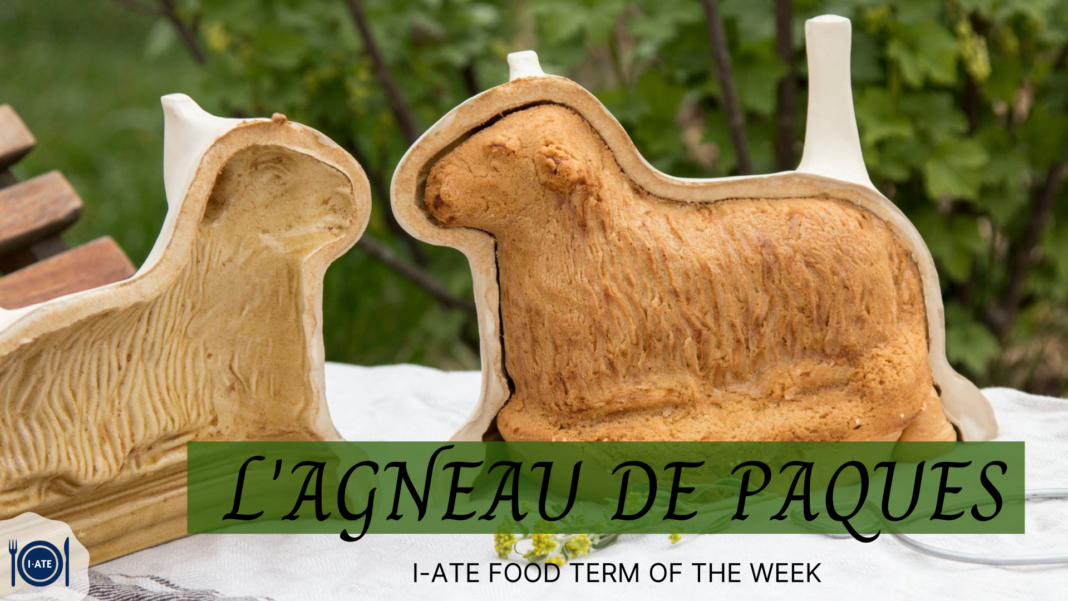In the northeast of France, Easter period is the perfect occasion to gather with all the family and to enjoy some local dishes and traditions. One of them is the so-called “Agneau de Pâques” or “Osterlammele”. This Easter sweet comes originally from the Alsace region. It is also very famous in the French Moselle department, a bit further in the north. Literally meaning, “the small lamb”, this sponge cake was usually eaten on the morning of Easter Sunday, right after the Church Service. The creation of this dish dates back to the 16th century, when grandmothers were preparing specialties for the Easter gatherings. Even though it can be associated to children, since the shape itself looks like a lamb, the tradition is to share it with the entire family for breakfast.
Nowadays, you mostly find it in the Alsatian bakeries and pastries in different shapes and with a lot of powdered sugar on it. The bakers use ceramic baking tins to make the cakes look exactly like a lamb. Some of these baking tins can be very ancient, even considered as popular art in Alsace! Some of them are displayed in the Musée Alsacien in Strasbourg. There used to be created in Soufflenheim, also known as “Cité des Potiers”, the “City of the Potters” in English. Very famous for its pottery work since the Bronze Age, the city is still a cradle of the pottery business in Alsace. If you want to try it at home, you can easily find specific and more recent bakery tins to make your own “Agneau de Pâques”.

This fresh and very smooth biscuit is usually very big and it can look quite impressive when you see it for the first time. It is very traditional to put the Alsatian flag on it to decorate. However, the slurry paste makes it so light and so easy to eat. It even melts in your mouth immediately. If you are not careful, you can be caught eating all of it! It is definitely so hard to share! They all look very similar but each of them is unique. Even though it is done in the same baking tins, every lamb is quite different and it looks very different depending on the amount of powdered sugar you choose to put on it. You can have small and individual ones. The only rule is not to eat it outside Easter period. This sweet dish is mainly composed of eggs but some variants in the recipe are emerging like to put cornflour or even lemon peel.
If you want to try the traditional one, you should definitely go to a traditional bakery or pastry in Alsace or Moselle! It requires some good cooking skills but still it can be done in an hour!

Here is a picture of our TermCoord’s Agneau de Pâques
References:
Lammele. 2022. L’histoire du Lammele d’Alsace – Lammele.fr. [ONLINE] Available at: https://lammele.fr/histoire.html [Accessed 22 April 2022].
Le Monde.fr. 2022. L’agneau pascal (Osterlammele) : la recette de Faustine Régnier. [ONLINE] Available at: https://www.lemonde.fr/les-recettes-du-monde/article/2022/04/14/l-agneau-pascal-osterlammele-la-recette-de-faustine-regnier_6122188_5324493.html. [Accessed 22 April 2022].
marmiton.org. 2022. Agneau de Pâques (Osterlammele) : recette de Agneau de Pâques (Osterlammele). [ONLINE] Available at: https://www.marmiton.org/recettes/recette_agneau-de-paques-osterlammele_22178.aspx. [Accessed 22 April 2022].
Une tradition alsacienne : l’«Osterlammele».. 2022. Une tradition alsacienne : l’«Osterlammele».. [ONLINE] Available at: http://osterlammele.canalblog.com/. [Accessed 22 April 2022].

Written by Cécile Mayeres
She holds a Master’s degree in Translation and Cross-Cultural Communication with a specialization in European mobility. She now does a traineeship in Communication at the Terminology Coordination Unit.

